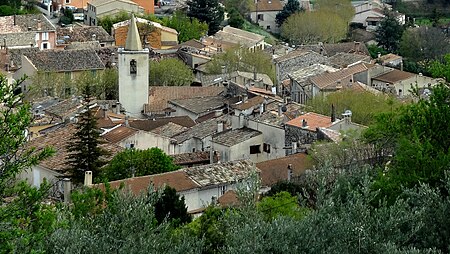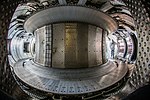ITER (initially the International Thermonuclear Experimental Reactor, iter meaning "the way" or "the path" in Latin) is an international nuclear fusion research and engineering megaproject aimed at creating energy through a fusion process similar to that of the Sun. It is being built next to the Cadarache facility in southern France. Upon completion of construction of the main reactor and first plasma, planned for 2033–2034, ITER will be the largest of more than 100 fusion reactors built since the 1950s, with six times the plasma volume of JT-60SA in Japan, the largest tokamak operating today.
The long-term goal of fusion research is to generate electricity. ITER's stated purpose is scientific research, and technological demonstration of a large fusion reactor, without electricity generation. ITER's goals are to achieve enough fusion to produce 10 times as much thermal output power as thermal power absorbed by the plasma for short time periods; to demonstrate and test technologies that would be needed to operate a fusion power plant including cryogenics, heating, control and diagnostics systems, and remote maintenance; to achieve and learn from a burning plasma; to test tritium breeding; and to demonstrate the safety of a fusion plant.
ITER's thermonuclear fusion reactor will use over 300 MW of electrical power to cause the plasma to absorb 50 MW of thermal power, creating 500 MW of heat from fusion for periods of 400 to 600 seconds. This would mean a ten-fold gain of plasma heating power (Q), as measured by heating input to thermal output, or Q ≥ 10. As of 2022, the record for energy production using nuclear fusion is held by the National Ignition Facility reactor, which achieved a Q of 1.5 in December 2022. Beyond just heating the plasma, the total electricity consumed by the reactor and facilities will range from 110 MW up to 620 MW peak for 30-second periods during plasma operation. As a research reactor, the heat energy generated will not be converted to electricity, but simply vented.
ITER is funded and run by seven member parties: China, the European Union, India, Japan, Russia, South Korea and the United States. In the immediate aftermath of Brexit, the United Kingdom continued to participate in ITER through the EU's Fusion for Energy (F4E) program; however, in September 2023, the UK decided to discontinue its participation in ITER via F4E, and by March 2024 had rejected an invitation to join ITER directly, deciding instead to pursue its own independent fusion research program. Switzerland participated through Euratom and F4E, but the EU effectively suspended Switzerland's participation in response to the May 2021 collapse in talks on an EU-Swiss framework agreement; as of 2024, Switzerland is considered a non-participant pending resolution of its dispute with the EU. The project also has cooperation agreements with Australia, Canada, Kazakhstan and Thailand.
Construction of the ITER complex in France started in 2013, and assembly of the tokamak began in 2020. The initial budget was close to €6 billion, but the total price of construction and operations is projected to be from €18 to €22 billion; other estimates place the total cost between $45 billion and $65 billion, though these figures are disputed by ITER. Regardless of the final cost, ITER has already been described as the most expensive science experiment of all time, the most complicated engineering project in human history, and one of the most ambitious human collaborations since the development of the International Space Station (€100 billion or $150 billion budget) and the Large Hadron Collider (€7.5 billion budget).
ITER's planned successor, the EUROfusion-led DEMO, is expected to be one of the first fusion reactors to produce electricity in an experimental environment.









